#construction estimate company
Explore tagged Tumblr posts
Text
How Construction Takeoff Services Enhance Your Competitive Edge in the Industry?

What Are Construction Takeoff Services?
Construction Takeoff Services analyze blueprints, project specifications, and other documents to determine the exact quantities of materials needed for the job. Whether it's concrete, steel, lumber, or other materials, company ensure that the quantities are calculated precisely, which allows for more accurate budgeting and resource planning.
The Benefits of Construction Takeoff Services
Improved Accuracy in Estimating Costs
One of the primary advantages of utilizing construction takeoff services is the increased accuracy of cost estimates. Accurate estimate company help prevent costly mistakes that could arise from miscalculations or overlooked details. When contractors rely on their own estimations, there’s a risk of underestimating material costs, overestimating labor requirements, or missing out on critical aspects of the project. By working with experts in estimating company, businesses can ensure that their estimates are based on precise data. These professionals use advanced software and tools to carefully calculate the quantities of materials and labor required, allowing contractors to produce detailed and accurate cost breakdowns. As a result, the chances of budget overruns or scope changes are minimized, which enhances the overall profitability and success of the project.
Faster Project Planning and Quotation Process
Construction takeoff services can dramatically speed up the process of planning and quoting for a project. Manual methods, while accurate, can be time-consuming and prone to human error. By outsourcing this task to a specialized team, contractors can save valuable time and resources that would otherwise be spent on in-house procedures. Furthermore, the use of software allows for quicker and more efficient calculations. The software can automate many aspects of the process, such as counting materials, calculating volumes, and generating reports. This results in faster project planning, which can give contractors the edge when bidding for projects. A quicker turnaround on quotes means that contractors can submit proposals to clients sooner, increasing their chances of winning contracts over competitors who may take longer to prepare estimates.
Better Resource Allocation and Budget Control
Construction takeoff services provide valuable insights into the quantities and types of resources needed for a project. With a clear understanding of the required materials and labor, contractors can better allocate their resources. This leads to a more efficient use of time and materials, reducing waste and minimizing delays. Company also plays a key role in maintaining budget control. By accurately estimating the costs of materials and labor, contractors can create more realistic budgets and avoid overspending. In many cases, an accurate estimate will highlight potential cost-saving opportunities, such as finding alternative suppliers for materials or adjusting the scope of work to meet budget constraints.
Reduction in Errors and Rework
Errors in projects can be costly, leading to delays, increased labor costs, and even legal disputes. One of the most common sources of error in projects is inaccurate data. When materials are ordered in excess or insufficient quantities, contractors can face unexpected delays and additional costs as they try to correct the mistakes. By using professional estimate company, the likelihood of errors is greatly reduced. Estimate Company ensure that the quantities are calculated accurately, leaving little room for mistakes. As a result, contractors are less likely to face the need for rework, which can eat into project timelines and budgets. The efficiency gained by avoiding errors and rework gives contractors a competitive edge, as they can deliver projects more quickly and cost-effectively than those relying on inaccurate or incomplete estimates.
Increased Competitiveness in Bidding
In a competitive market, the ability to submit accurate and timely bids can make or break a contractor’s chances of winning a project. Construction takeoff services enhance a construction estimate company competitiveness by providing the tools and insights needed to create well-informed bids. Accurate contractors to produce realistic proposals that account for all aspects of the project, reducing the risk of underbidding or overbidding. Furthermore, the speed with which accurate estimates can be generated gives contractors an edge over competitors who may take longer to submit their bids. In many cases, clients are looking for quick responses, and contractors who can provide detailed and accurate bids faster are more likely to win contracts.
Conclusion
In today’s fast-paced and highly competitive projects industry, staying ahead of the competition requires precision, efficiency, and the ability to manage costs effectively. The company offers numerous benefits, including improved accuracy, faster project planning, better resource allocation, and reduced errors.
#construction takeoff services#construction estimate company#construction estimating services#build design services#residential estimate services
0 notes
Text
Construction Estimating Services

Our Construction Estimating Services are designed to provide you with accurate and comprehensive estimates for your construction projects. Whether you're involved in residential, commercial, or industrial construction, our team of experienced estimators is here to assist you. We offer a range of services, including cost estimating, material takeoff, and consulting. Our estimators utilize industry-standard methods and cutting-edge software to ensure the highest level of accuracy.
#construction estimating services#construction#construction estimator#construction industry#construction company#cost estimation#construction estimating in nyc#Accurate Estimates
1 note
·
View note
Text
Xpand Projects specializes in construction estimating services for all types of building projects, from small renovations to large-scale developments.Visit https://xpandprojects.com.au/.
#Estimating Services Australia#construction estimator sydney#Construction Estimating Services#Construction Estimating Companies#Construction Estimator Services in Sydney
0 notes
Text
Project Management Building Services: What Is It and How It Started
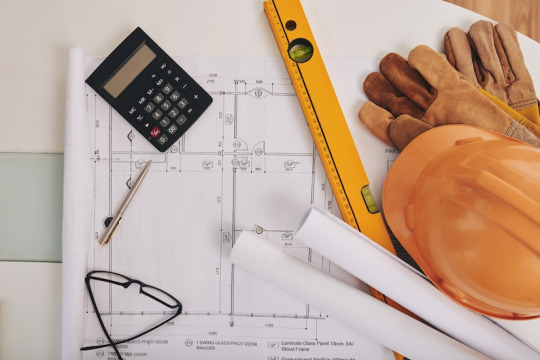
Project management building services begun in parallel to the existence of the construction industry. As the need for efficient projects and undertakings arise, so does the demand for project management building services.
Read more: https://crisscrossgroup.com.au/2022/08/26/project-management-building-services-2/
#project management building services#professional services and construction#home building services#planning design and construction#contract estimating services#residential construction companies Sydney#project management services Australia
0 notes
Text
The Role and Importance of Estimation Companies in the USA
Introduction
In the construction and project management industries, precision is paramount. Accurate cost estimation plays a pivotal role in ensuring the success of any project, from building a new skyscraper to remodeling a residential home. This is where estimation companies step in. These specialized firms are dedicated to providing precise and reliable cost estimates for a wide range of projects across the United States. In this article, we will explore the significance of Estimation Companies in USA, their functions, and the benefits they bring to various sectors.
The Role of Estimation Companies
Estimation companies, also known as cost estimating firms, are responsible for providing detailed cost assessments for projects. Their primary function is to calculate the expenses associated with a project, which helps clients, such as construction companies, property developers, and government agencies, make informed decisions about the feasibility of their endeavors. These estimations are critical for project planning, budgeting, financing, and ultimately ensuring that the project remains within budget.
Key Functions of Estimation Companies
Cost Estimation: Estimation companies employ a team of experts who are skilled in analyzing project requirements and generating detailed cost estimates. They consider various factors such as labor, materials, equipment, overhead costs, and contingencies. These professionals have extensive knowledge of industry-specific cost data, allowing them to provide highly accurate estimates.
Bid Preparation: For construction projects, estimation companies assist contractors and subcontractors in preparing competitive bids. They help clients understand the market conditions, evaluate subcontractor quotes, and calculate their own bids to secure contracts effectively.
Value Engineering: Estimation firms often engage in value engineering, which focuses on optimizing project costs without sacrificing quality. By suggesting cost-effective alternatives and design modifications, they can help clients save money without compromising the project's integrity.
Risk Assessment: Estimation companies also conduct risk assessments, identifying potential financial risks associated with a project. This includes assessing factors like market conditions, labor shortages, and material price fluctuations, enabling clients to prepare for potential challenges.
Benefits of Estimation Companies
Cost Accuracy: Estimation companies provide precise cost estimates, helping clients avoid costly surprises during project execution. This accuracy is especially crucial for projects with fixed budgets.
Time Savings: By outsourcing cost estimation to experts, clients save valuable time that would otherwise be spent on researching, calculating, and validating cost figures.
Improved Decision-Making: Reliable cost estimates allow clients to make informed decisions about project feasibility, scope, and financial planning, ultimately leading to successful project outcomes.
Enhanced Competitiveness: Contractors and developers can stay competitive in the market by having access to accurate and competitive cost estimates, helping them secure contracts and win bids.
Risk Mitigation: Estimation companies help clients identify and mitigate potential risks, reducing the chances of cost overruns and project delays.
Conclusion
Estimation companies in the USA play a vital role in various industries, ensuring that projects are executed efficiently, within budget, and with a high degree of accuracy. These specialized firms offer services that go beyond mere cost estimation, including bid preparation, value engineering, and risk assessment. The benefits of partnering with an estimation company are manifold, including cost accuracy, time savings, improved decision-making, enhanced competitiveness, and effective risk mitigation. As the construction and project management industries continue to evolve, the role of estimation companies remains indispensable in the pursuit of successful projects across the United States.
0 notes
Text
Golden Keys Construction is a reputable construction company in Chennai. With a proven track record of excellence in the construction industry, we specialize in delivering high-quality construction solutions for a wide range of projects. Our commitment to precision, innovation, and customer satisfaction sets us apart as a leader in the field.
#Construction company in C#hennai#Construction company#construction workers#construction industry#builders#architectural#construction estimating services
1 note
·
View note
Text
Sydney Estimator is a team of experts in construction estimation and project management who serve Sydney and NSW. We provide cost effective Construction Estimating Services for the Building and Construction Industry.
#construction estimating company near me#qs sydney#quantity surveyor#quantity surveyor construction#quantity surveyor report
0 notes
Text
#top construction management firms in florida#commercial construction management company florida#project management residential construction#project management for construction industry deerfield beach#best construction cost estimators in florida
0 notes
Text
#construction estimating companies#estimating service suffolk county#civil engineering#construction#concrete#building#estimating software#construction estimating services
1 note
·
View note
Text
"As 3D-printing methods continue to evolve, it’s not uncommon to see this method employed for various engineering projects, especially in the construction of affordable housing, structures, and schools.
In Ireland, a first-of-its-kind social housing project has been built from the ground up, using 3D printing as a time and money-saving solution.
In fact, it’s Europe’s first 3D-printed social housing project, fully compliant with international standards. In Grange Close, Dundalk, the three-unit terraced build is now a milestone achievement in eastern Ireland. It was created by Harcourt Technologies Ltd (HTL.tech) and assembled using COBOD’s BOD2 3D construction printer.
The unit is 3,550 square feet and is divided into three separate homes, each measuring 1,184 square feet.

The use of this technology allowed for a 35% faster construction process, which took 132 days from start to finish. During that time, the 3D-printed superstructure itself was completed in just 12 printing days.
Conventional construction methods usually require more than 200 days, according to COBOD, meaning this method could be transformative in quickly scaling affordable housing options.
“Ireland’s housing crisis, driven by a decade of under-construction and rising demand, has reached critical levels, leading to widespread protests and influencing national elections,” HTL.tech shared in a press release.
“The rapid construction made possible by 3D printing offers a promising solution. The homes in Dundalk demonstrate how this technology can address housing shortages by dramatically reducing construction time and costs.”
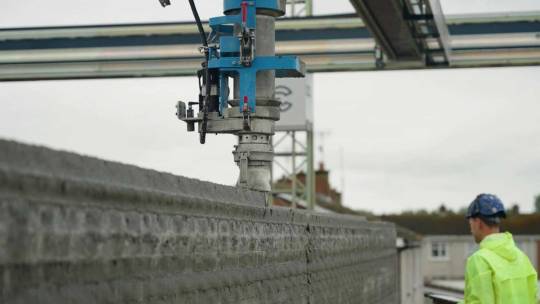
In the 132 days it took to go from initial site preparation to handing over keys to the client, builders say approximately half of the time savings came directly from 3D printing.
Additionally, during the project, COBOD upgraded the concrete hose of its printer, which increased its output by 40% and significantly increased the printing speed. With this upgrade, the company estimates that printing times for similar structures would be reduced to nine days instead of 12.
“We continue to improve our technology,” Henrik Lund-Nielsen, general manager and founder of COBOD International, said in a statement, “and although a hose update can be seen as a small step, the numbers from HTL.tech proves that it is not.”
Now, the client — a local housing council — will finish furnishing the homes and will rent them to social housing tenants at an affordable price.

It’s a success that will surely have ripple effects.
“As the first 3D-printed social housing project in Europe, the Grange Close development sets a precedent for future housing solutions,” a press release from HTL.tech explained. “With countries like Sweden and Germany also experimenting with 3D-printed homes, this technology is poised to become a standard approach for addressing housing shortages.”
The statement also added that governments across Europe may increasingly adopt 3D printing to “deliver faster, more cost-effective housing solutions for low-income residents.”
“This project not only showcases the potential for rapid, sustainable construction but also serves as a blueprint for other nations facing similar challenges,” the statement concluded. “As 3D printing technology evolves, its role in shaping the future of housing construction looks increasingly promising.”"
-via GoodGoodGood, January 23, 2025
#ireland#europe#housing#housing shortage#affordable housing#housing crisis#3d printing#architecture#good news#hope
768 notes
·
View notes
Text
"The Goon Economy: Why People Choose to Work for Supervillains"
Leslie Lester, for Psychology Today, October 2022
When asked why anyone would choose to work for supervillains, most people imagine costumed henchmen cackling maniacally while fighting Spider-Man. The reality is far more mundane - and more economically fascinating.
"It's just a job," says Former Employee X under the condition of anonymity, who worked security for a major East Coast villain organization. "Better benefits than Netsphere, better pay than private security, and yeah, higher risk, but you've got clear procedures for hero encounters. Most guys never even see a cape."
The numbers support this pragmatic view. While exact figures are difficult to obtain, conservative estimates suggest supervillain organizations employ hundreds of thousands of workers across the U.S., from direct muscle to legitimate business employees. The total economic impact likely rivals major corporations.
But why choose such high-risk employment? Dr. Sarah Chen, economist at MIT, suggests three key factors:
Economic Pressure: "In cities with active supervillain presence, these organizations often control major employment sectors - construction, shipping, waste management. Sometimes working for them isn't really a choice."
Risk vs. Reward: The average "muscle" for a villain organization makes 1.5-2 times standard security work, with comprehensive health coverage and legal protection. "When you're living paycheck to paycheck," Chen notes, "guaranteed medical care becomes very attractive."
Systemic Integration: Many workers start through legitimate businesses, becoming gradually involved in illegal activities. "It's rarely a conscious choice to 'become a minion,'" Chen explains. "It's more like finding out your company has mob ties - but you've got a mortgage and kids in school."
The psychology is equally complex. Dr. James Morrison of Harvard explains: "These organizations offer what many legitimate employers don't: clear advancement paths, protection from both heroes and rivals, and often a sense of belonging. They're filling gaps in our social safety net."
The rise of powers-based crime has only increased this trend. "Supervillain organizations have better protocols for superhuman encounters than most legitimate businesses," Morrison notes. "If you're working in a city where hero-villain battles are common, that matters."
530 notes
·
View notes
Text
Why Professional Rebar Estimating Services Matter for Structural Integrity and Cost Control?

Introduction
In the world of construction, the significance of each material used in a project cannot be overstated. Among the materials that play a crucial role in ensuring the safety, durability, and longevity of a structure. Rebar is the backbone of reinforced concrete, providing strength and stability to buildings, bridges, highways, and other infrastructures. However, as vital as rebar is to construction, the process of rebar estimating services is the correct amount, size, and placement is equally important.
Ensuring Structural Integrity
A well-constructed structure depends on precise engineering, and rebar is a vital part of that equation. Rebar reinforces the concrete, helping to manage the tension forces that the concrete alone cannot handle. For instance, in a building, bridge, or road, rebar placement must be meticulously calculated and positioned to ensure safety and stability. If the rebar is insufficient, or incorrectly placed, the structural integrity of the entire project could be compromised, leading to dangerous consequences like cracks, settlement, or even failure under stress. Professional rebar estimating services ensure that the exact quantity, size, and type of rebar needed for a project are correctly calculated from the beginning. Estimators factor in various design elements, including load-bearing calculations, structural requirements, and the type of environment the structure will face (e.g., exposure to corrosive elements).
Accurate Cost Control
One of the primary reasons why professional rebar estimating services matter is their ability to control costs effectively. Rebar is often one of the most significant material costs in a construction project. A miscalculation in quantity or incorrect material specifications can lead to budget overruns, material shortages, or unnecessary procurement of excess stock. Both scenarios are costly and time-consuming, leading to delays and waste. Professional construction estimate use specialized software tools and industry knowledge to provide highly accurate estimates. These tools factor in the dimensions of the structure placement, and spacing, ensuring that the right amount of material is purchased without excess. Construction projects often produce material waste, but accurate estimates help reduce unnecessary surplus. This ensures that the project does not experience unexpected shortages or additional costs due to over-ordering.
Minimizing Delays and Enhancing Project Timelines
Accurate rebar estimating helps ensure that the project progresses smoothly without delays. When rebar quantities and materials are miscalculated, it can lead to significant setbacks. For example, if there is a shortage of rebar or incorrect materials are ordered, work may need to be halted until the issue is resolved. These delays can result in extended project timelines and higher labor costs as workers wait for materials. With professional rebar estimating, contractors can anticipate the required quantities early in the process, helping to ensure that the correct materials are on-site when needed. By planning, construction estimators can also take into account factors such as the size of the project, the delivery schedule, and the work sequence, ensuring that materials arrive on time and without delay. This helps keep the project on track and prevents costly downtime.
Reducing Risk and Enhancing Safety
Construction projects inherently involve a degree of risk, and safety should always be a top priority. Incorrectly estimated rebar quantities or poorly placed rebar can create dangerous working conditions, particularly when construction workers are handling heavy materials or dealing with tensioned structures. Structural failures, even small ones, can cause significant safety hazards on-site. Professional rebar estimating services help mitigate these risks by ensuring that the project is designed and executed with optimal structural strength. Rebar estimators are also well-versed in construction safety protocols, helping to ensure that the right amount of material is used, and the rebar is installed as designed. This reduces the likelihood of hazardous scenarios such as collapsing beams or slabs.
Precision and Detailing for Complex Projects
Large-scale or complex construction projects, such as high-rise buildings, bridges, or industrial plants, often require intricate rebar installations. These projects demand a high level of precision when construction estimating and placing rebar due to the complexity of the structural design and the scale of the work. Manual calculations can easily lead to mistakes, resulting in costly errors and project delays. Professional rebar estimating services are equipped with advanced tools and methods to handle these complex calculations accurately. They provide highly detailed takeoffs and blueprints, indicating the exact placement and number of required in each section of the structure.
Long-Term Maintenance and Durability
The longevity and durability of a structure depend significantly on the quality of the materials used, including the rebar. Incorrectly estimated or inferior-quality rebar can lead to structural issues over time, such as corrosion or weakening of the concrete. Professional estimators consider factors like environmental exposure and the long-term demands on the structure, ensuring that the right type of rebar is specified.
Conclusion
Professional rebar estimating services are crucial for any construction project, ensuring that the structure's integrity is maintained, costs are controlled, and project timelines are adhered to. The precision, knowledge, and experience estimators bring to the table help minimize errors, reduce waste, and enhance safety on-site. By working with professional estimators, contractors and project managers can avoid costly mistakes, optimize material usage, and ensure that their projects are built to last. Whether constructing a skyscraper, bridge, or residential building, investing in professional rebar estimating services is a smart decision for any construction project.
#rebar estimating services#construction estimating services#construction estimating company#build design services#residential estimating services
0 notes
Text

BEIJING — China’s struggling real estate developers won’t be getting a major bailout, Chinese authorities have indicated, warning that those who “harm the interests of the masses” will be punished.
“For real estate companies that are seriously insolvent and have lost the ability to operate, those that must go bankrupt should go bankrupt, or be restructured, in accordance with the law and market principles,” Ni Hong, Minister of Housing and Urban-Rural Development, said at a press conference Saturday.
“Those who commit acts that harm the interests of the masses will be resolutely investigated and punished in accordance with the law,” he said. “They will be made to pay the due price.”
That’s according to a CNBC translation of his Mandarin-language remarks published in an official transcript of the press conference, held alongside China’s annual parliamentary meetings.
Ni’s comments come as major real estate developers from Evergrande to Country Garden have defaulted on their debt, while plunging new home sales have put future business into question.
In 2020, Beijing cracked down on developers’ high reliance on debt for growth in an attempt to clamp down on property market speculation. But many developers soon ran out of money to finish building apartments, which are typically sold to homebuyers in China ahead of completion. Some buyers stopped paying their mortgages in a boycott.
Authorities have since announced measures to provide some developers with financing. But the national stance on reducing the role of real estate in the economy hasn’t changed.
This year’s annual government gathering has emphasized the country’s focus on investing in and building up high-end manufacturing capabilities. In contrast, the leadership has not mentioned the massive real estate sector as much.
Real estate barely came up during a press conference focused on the economy last week, while Ni was speaking during a meeting that focused on “people’s livelihoods.”
Ni said authorities would promote housing sales and the development of affordable housing, while emphasizing the need to consider the longer term.
Near-term changes in the property sector have a significant impact on China’s overall economy.
Real estate was once about 25% of China’s GDP, when including related sectors such as construction. UBS analysts estimated late last year that property now accounts for about 22% of the economy.
Last week, Premier Li Qiang said in his government work report that in the year ahead, China would “move faster to foster a new development model for real estate.”
“We will scale up the building and supply of government-subsidized housing and improve the basic systems for commodity housing to meet people’s essential need for a home to live in and their different demands for better housing,” an English-language version of the report said.
next time you complain about how things are in America, consider that if you lived in some kind of scary communist country like China, you wouldn't even get to fund a bailout for the real estate company owners who ruined the economy like you can (whether you like it or not) in the good old US of A! 🇺🇲
1K notes
·
View notes
Text
Xpand Projects specializes in construction estimating services for all types of building projects, from small renovations to large-scale developments.Visit https://xpandprojects.com.au/.
#Estimating Services Australia#construction estimator sydney#Construction Estimating Services#Construction Estimating Companies#Construction Estimator Services in Sydney
0 notes
Text




On February 21st 1842 Scotland’s first inter-city railway, the Edinburgh-Glasgow mainline, opened to regular traffic.
The building of a railway between the two cities was authorised by an Act of Parliament in 1838 following several years of public discussion.
Construction work on the 46-mile line took almost four years. It was no easy task. To ensure a level route, numerous cuttings were dug, four viaducts were built and three tunnels were driven through hills and solid rock. Members of the public were invited to walk through the Queen Street tunnel on New Year’s Day 1842 to satisfy growing interest in the project. The line opened to regular services on 21st February that year, following a ceremonial opening of the station three days earlier, as I posted on Sunday.
The railway put an end to the slow and cumbersome stagecoaches that had linked Glasgow and Edinburgh for more than a century, and would eventually drive business away from the canal network as well.
The project’s engineers had wanted to build a bridge over the Forth and Clyde canal – but the canal’s owners refused. A tunnel under the waterway had to be constructed instead.
The Scotsman reported in February 1842 that “it rarely happens that a railway can be brought into the centre of a great city”, as it announced the opening of Queen Street station in Glasgow. But the original Edinburgh terminus at Haymarket was greeted with rather less enthusiasm. It was hoped that eventually the train line would stretch further into Edinburgh.
An extension to North Bridge was duly completed in 1846, and work on building the present Waverley station began in 1868.
The line was popular with passengers from the beginning. Initially, four services travelled in each direction from Monday to Saturday. Controversially, two services also ran on Sundays – provoking strong opposition from Sabbatarians. The number of trains throughout the week quickly increased.
Passengers could choose to alight at many more intermediate stations than today – with stops at Gogar, Ratho, Winchburgh, Linlithgow, Polmont, Falkirk, Castlecary, Croy, Kirkintilloch (later Lenzie) and Bishopbriggs. The Edinburgh & Glasgow Railway Company which built the line was absorbed by the North British Railway (NBR) in 1865. The NBR would in turn be absorbed by the London & North Eastern Railway in 1923.
There have been several high-profile train crashes on the route over the years. The most recent occurred on 30th July, 1984, when a rush hour commuter service out of Waverley struck a cow that had wandered on to the tracks near Polmont from a nearby field. The collision caused all six carriages to derail, killing 13 people and injuring 61 others.
The worst accident, in terms of loss of life, took place on 10th December, 1937, at Castlecary. During a snowstorm, the 5.30pm Waverley to Queen Street express collided with a late running local train from Dundee to Glasgow. The locomotive hit the rear of the standing local service at the now-closed Castlecary station at an estimated 70mph. Four carriages were completely destroyed by the collision, killing 35 passengers and injuring 179 more.
The £742m Edinburgh Glasgow Improvement Programme (EGIP) is the biggest project on the route since it was built 174 years ago. It will eventually see all-electric trains operating on the line, with faster journey times and more seats for passengers. The average journey time by train between Glasgow and Edinburgh (Waverley) is now 1 hour and 14 minutes, with around 191 trains per day.
A new passenger hall at Haymarket station opened in 2014, while Queen Street was recently comprehensively rebuilt.
168 notes
·
View notes
Text


Mass Grave of Roman Soldiers Discovered in Austria
The renovation of a football pitch in Austria’s capital has led to the discovery of a Roman mass grave housing the remains of more than a hundred soldiers who died in combat.
The construction company working on the sports field in the district of Simmering in Vienna found a large number of human remains at the site in late October, according to the Vienna Department of Urban Archaeology, part of the Wien Museum.
The remains of at least 129 individuals were uncovered during excavations by archaeologists and anthropologists from the museum and archaeological excavation company Novetus, the museum said in a press release Wednesday.
However, the total number of individuals is estimated to be more than 150, as the earlier construction works had displaced a large number of dislocated bones in the 16-foot-long pit.
The skeletal finds suggest “a hasty covering of the dead with earth,” as the individuals were not buried in an orderly fashion, but with their limbs intertwined with each other’s and with many lying on their stomachs or sides, the museum said.
‘Catastrophic’ military operation
After the skeletons were cleaned up and examined, researchers found that they were all male, and most were more than 1.7 meters tall (more than 5 feet 7 inches) and between the ages of 20 and 30 when they died.
Their dental health was generally good, with few signs of infection, but every individual analyzed bore injuries sustained at or near their time of death.

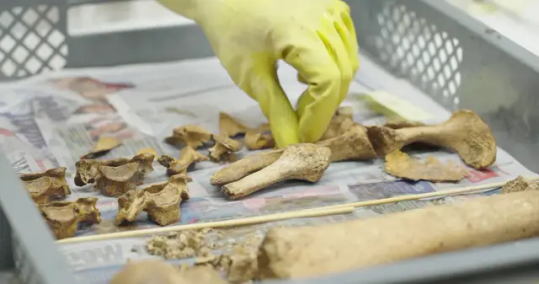
The variety of wounds, which were mainly found in the skull, pelvis and torso, and made by weapons including spears, daggers, swords and iron bolts, suggests they were sustained during battle rather than the result of execution – the punishment for military cowardice, the museum said.
“As the remains are purely male, it can be ruled out that the site of discovery was not connected with a military hospital or similar or that an epidemic was the cause of death. The injuries to the bones are clearly the result of combat,” it added.
The bones were dated to approximately 80 to 230 AD.
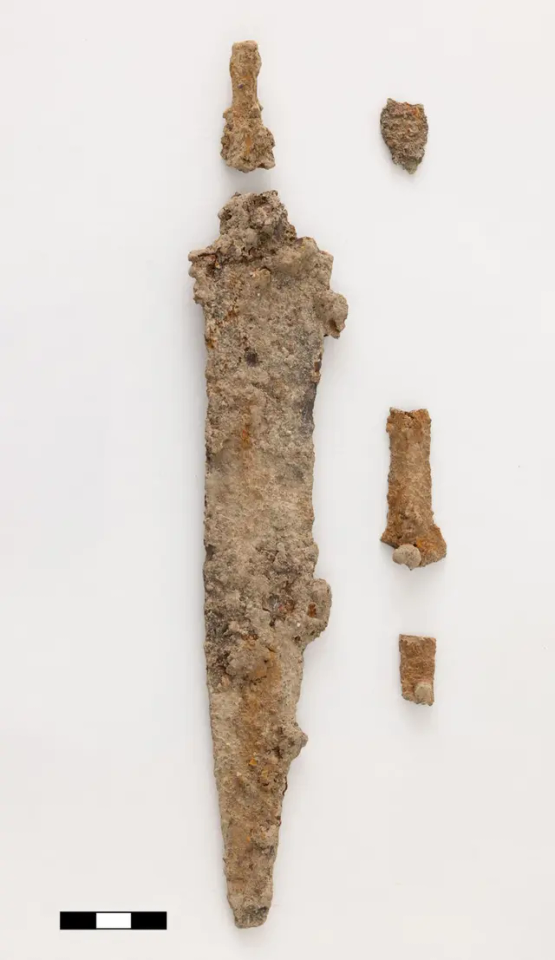

The men were probably robbed of their weapons, since only a small number of objects were found alongside them, according to the release.
Archaeologists uncovered two iron spearheads, one of which was found lodged in a hip bone.
Numerous hobnails were discovered near the feet of one individual. These nails would have studded the underside of leather Roman military shoes, the museum said.
An X-ray of the scabbard of a rusted and corroded iron dagger revealed typical Roman decorations of inlays of silver wire. This was dated to between the mid-1st century and early 2nd century AD.
There were also several pieces of scale armor, which became customary around 100 AD, the museum said. However, they were unusual in having more square-shaped features than round, it added.
A cheek piece from a Roman helmet was found to be from a type that became customary from the middle of the 1st century.
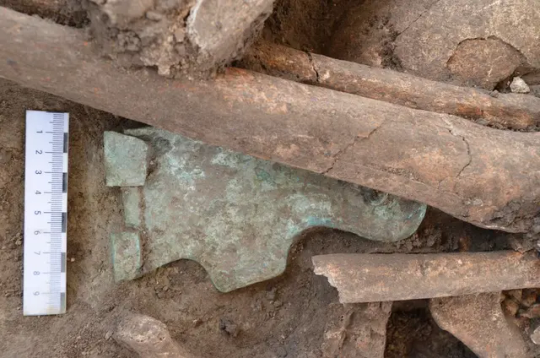



“We are blown away by this find. It is a genuine game-changer,” Kristina Adler-Wölfl, head of the Vienna Department of Urban Archaeology, said Friday, adding that this is “a once-in-a-lifetime discovery” for the museum’s archaeologists.
“There is archaeological evidence of Roman battlefields in Europe, but none from the 1st/2nd century CE with fully preserved skeletons,” she said.
Around 100 AD, ritualized cremation burials were common in the Roman-governed parts of Europe, with whole-body burials “an absolute exception,” according to the museum. “Finds of Roman skeletons from this period are therefore extremely rare,” it said.
“The undignified nature of the burial site along with the deadly wounds found on each individual suggests a catastrophic military confrontation, possibly followed by a hasty retreat,” Adler-Wölfl added.



Battle at the dawn of urban Vienna
Historical records show that in the late 1st century, during the reign of the emperor Domitian, costly battles took place on the Roman Empire’s northern Danube border between the Romans and Germanic tribes.
“This is the first time we have material evidence of the Germanic wars” fought by Domitian between 86 and 96 AD, Adler-Wölfl said. “Before the find, we knew about these conflicts only through some written sources.”
“Our preliminary investigation suggests with near certainty that the mass grave is the result of such a Roman-Germanic battle, one that likely took place in or around 92 CE,” she added.
The destruction of an entire legion is included in reports of disastrous defeats, which later led to the extension of the fortification line known as the Danube Limes under the emperor Trajan, according to the museum.
The Roman expansion of the town of Vindobona, which later became Vienna, “from a small military site to a full-scale legionary fortress occurred in that context,” said Adler-Wölfl.
“This would place the mass grave in immediate conjunction with the beginning of urban life in present-day Vienna,” she added.
The initial investigation by the team in Vienna will form part of a larger international research project, the museum said. This will include DNA analysis, to shed light on the lives of the soldiers and their living conditions.



#Mass Grave of Roman Soldiers Discovered in Austria#Simmering in Vienna Austria#roman battelfield#mass grave#roman weapons#ancient artifacts#archeology#history#history news#ancient history#ancient culture#ancient civilizations#roman history#roman empire#roman emperor
98 notes
·
View notes